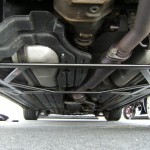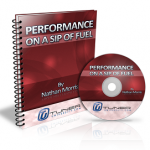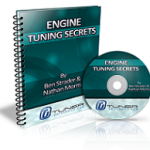No matter what car you drive, there are a number of suspension braces available  to supposedly improve handling. People shell out hundreds, even thousands of dollars on strut bars, under body braces, suspension member braces, fender braces, and frankly braces that attach to just about anything that has a bolt in it.
to supposedly improve handling. People shell out hundreds, even thousands of dollars on strut bars, under body braces, suspension member braces, fender braces, and frankly braces that attach to just about anything that has a bolt in it.
But what do these bars really do, if anything? Are all braces the same or are there important differences between them?
In today's article, I hope to begin to decode a little bit about each of these extremely important questions. While everyone just assumes they wouldn't be so popular if they didn't "work", I am here to tell you that there are far more bad products on the market than good ones - especially when it comes to chassis braces.
I am going to limit my discussion here to strut braces as they are generally the most effective and common. However, aside from placement, all other braces you can fit to your car are going to have a similar function.
What is a strut bar?
A strut bar is a simple metal bar that connects the left and right strut tower. The idea is that by tying them together, you reinforce the frame of the car and therefore you reduce chassis flex. It's the same idea as adding an cross beam stud to a wall in your house.
The placement of the strut bar is particularly important as it is tying two of the most stressed points together and helping to prevent the body of the car from flexing due to a strong force to one side or the other.
For example, when you go over a raised bump with your right tire, the spring compresses as the wheel pushes up on the body. This force, if high enough, can actually cause the metal body of the car to move and twist. When this occurs, especially during high speed cornering, it can affect the suspension's alignment temporarily and actually make the car feel less stable and predictable.
What do chassis braces DO?
Well, strut bars, contrary to popular belief, are not going to measurably increase your G-force handling in the corners. They won't even measurably increase your cornering speed. They may, in some cases, improve your transitional speed (ie, your slalom speed, or perhaps in better layman terms - the speed at which the car changes directions). However, their primary contribution to your car is to HANDLING (or feel).
Now, I am just as guilty as anyone for using the term handling and grip interchangeably. However, they are quite different. Handling really refers (at least in my mind and for the purposes of this article) to how the car feels to the driver, how well it communicates what is going on to them, and also how stable it is - especially at the limit of grip.
There are many cars that I've driven that were extremely fast through the bends, but not exactly confidence inspiring. Because of their vague handling, they were very difficult to drive to the limits of the car and they were also somewhat frightening to drive rather than "fun to drive".
A strut brace will often improve the handling of the car, but understand that handling is highly subjective. As a general rule, the stiffer the chassis, the more predictable the handling, the longer the life of the chassis (especially if being raced), and the easier the car will be to drive at the limit.
Poor handling cars are not necessarily lacking in grip, they are lacking in feel or transitional response. Hopefully this illustrates what I'm on about.
Finally, chassis braces do two other things that I won't talk too much about in this article because they are more theoretical. They are however important to understand. The first is that the chassis is basically just as much a spring as the springs in your suspension. Though, the chassis is more like the sway bars in your suspension in that it acts as a torsion spring.
This is why you'll often hear people say that sway bars increase torsional (twisting) strength of the chassis. Anyhow, all this means is that as you go down the road or turn into a corner, the steel body of the car will bend with the forces applied to it by the suspension and things like centrifugal force. Obviously it doesn't flex much, even in factory form, or you'd not only notice but you'd have a rather dangerous vehicle.
Modern vehicles especially are quite stiff from the factory, if for no other reason than it generally makes them hold up better in accidents. The other reason is letting the suspension do its job. You see, when the body is twisting, it's changing the location and angles of the suspension as well. This messes with the alignment of the wheels in a corner or going over a bump. The body's flex is also difficult to monitor so it can lead to troublesome suspension tuning. In other words, if the body is flexing about, it's much harder to tune out undesirable suspension traits because it's much harder to pinpoint what's causing that handling problem. A stiff chassis makes it very easy to isolate suspension problems and tune them out. It also keeps the tires in the location the suspension designer intended, with the desired behavior as well.
So are they useless?
It depends. Chassis braces can be extremely worthwhile, or they can be an excessive waste of money.
The difference depends on what you're trying to accomplish, the car you started with, and ultimately - what the brace is constructed of and how it's constructed.
Let's start with the goals part. A strut brace is primarily going to be an improvement to the feel of your car. If you're trying to improve instrumented numbers (ie, g-force in corners), you probably won't see much there. If you're trying to improve times, you may or may not see huge improvements, depending on you as a driver - not so much the brace in use.
The variables are many here, but as a general rule - the strut brace allows more mortal drivers the ability to drive their cars closer to the limit by giving the car a more predictable and stable feel. A true professional driver would probably prefer a really stiff chassis, but could most likely turn similar if not identical times with and without the added stiffness (obviously there are extremes!!).
That said, if you want to build a fun to drive "driver's car" or if you want to generally improve the handling and predictability of your car - a strut brace (or any brace) can really be a great addition.
Which Braces to Buy?
In most cars, the front strut brace is going to have the biggest impact of all of them. In most cars, for most drivers, this is going to be plenty. The front wheels are by far the most stressed due to the fact that they must steer the vehicle in all sorts of situations while also dealing with imperfections in the road, weight transfer, and other stresses.
The front wheels are usually also located roughly in the middle of or just to the rear of the largest hole in the vehicle's chassis. In other words, the place where the least reinforcement exists due to practical reasons - the engine is there.
You'll also find that any time a factory supported tuning job is done to a car, they add a front strut bar, and only sometimes a rear one. The rear one is usually omitted because it's of less importance and it usually comes at the expense of cargo and passenger space - something most OEMs are not really willing to give up.
The other braces, well, they're possibly helpful for hardcore track and track-day cars. However, for most of you - you're better off spending your money elsewhere. The returns are minimal from the rest of the bracing despite the hype. If you're going to do much more than a front and rear strut brace, you should consider a roll cage as you'll be needing one anyway if you're pushing your car to that sort of limit.
What about Brace Construction?
There are two things that bother me about nearly all strut braces (and indeed other braces designed for most cars). First of all, they have a hinged part, almost always in the same plane as the stresses that will be applied to the bar.
Most popular eBay-type braces (and even JDM uber-expensive ones!) have a piece that bolts to the strut tower and then the bar itself bolts into place after that. This is a terrible design and one that will render the brace nearly useless under many circumstances.
Take a look at OEM-designed strut braces and in almost all cases (especially where an engineer was asked), they are SOLID pieces, generally steel in construction.
Why steel? Well, for one it's cost. However, and this is the other thing that bugs me about most aftermarket braces - Aluminum in this application has ZERO advantage of steel. Why?
Aluminum and steel have the same stiffness, given the same amount of weight. In other words, if you go to the hardware store and pick up a piece of 1" bar aluminum, you'll find that while it is much lighter than the same size piece of steel.... it's a great deal flimsier.
It will take the same amount of weight in aluminum (and thus a bigger bar) to provide the same amount of stiffness as the equivilant weight steel. Aluminum strut braces, floor bars, fender braces, and so on - would have to be unreasonably large to add any real stiffness.
So, yes, you absolutely should try to find a SOLID, steel-based brace whenever possible, or have one constructed for you.
Aluminum strut braces are okay, as long as they are bulky and solid with no hinge - they're better than nothing, but I'll take a steel version any day over the aluminum.
Let's talk a little more about the aluminum vs steel argument. Roll cages are always made out of? Steel. The frame of your car is almost always .... 100% steel. Why? Well, because the only material that can be as stiff as steel is carbon fiber - and it has it's problems not to mention expenses.
Aluminum has its place, in unstressed body panels for example. But what about aircraft aluminum, isn't it as strong as steel? Well, sort of, but it's extremely flexible too - think about how much the air plane wings move about when you're flying (scary sometimes how much they move!).
With all of this said, I will admit that finding a STEEL brace of any kind for any car can be quite difficult. There are a few manufacturers out there that use steel, but I do not want to plug them here. TRD is one of the ones that come to mind, the Honda Type R strut braces (from memory) I believe were also steel. You should, however, seek these companies out. I know one of them has a very awesome demonstration of a typical strut bar under stress and a steel one under stress. I'll give you guys a hint, it's a Malaysian company.
Understand that you are trying to brace an already rather strong steel structure, you want to strengthen it with something at least as stiff as it is. Otherwise, it's like adding a wood cross brace to a steel building structure. Sure it may add a very small almost immeasurable amount of strength, but it's pretty useless at the end of the day at adding strength. Regardless of the brand name on the wood.
More on this topic (including more illustrations, sorry my camera was missing in action this week) to come.
Good luck!
Extremely Limited Time Offer - 3 Days Only
Get a MASTERS DEGREE in Performance Tuning from the BEST in the Field for ONE low package price
For 3 days only, get ALL of our PREMIUM (not available anywhere else) Tuner University Courses featuring some of the greatest minds in motorsports:
- Top 10 Performance Myths Class (MP3 and Edited Transcript) - $29.95 value
- Performance on a Sip of Fuel Class (MP3 and class manual) - $69.95 value
- Header Design Secrets with John Grudynski (MP3 and transcript) - $69.95 value
- Dirty Secrets of Oil with Ryan Stark (MP3 and transcript) - $69.95 value
- Engine Tuning Secrets with Ben Strader of EFI University (MP3 and Transcript) - $69.95 value
Get all of the above courses (many of which not currently available anywhere else) for one single price of just $309.75 $69.95. A HUGE package savings.
You can also buy any of these individually through our resource center, but I don't know why you would as this is basically the whole store for the price of just 1 course. You'll get the MP3 recordings of each class as well as a transcript or companion manual with each course and you'll be able to download them all INSTANTLY.





